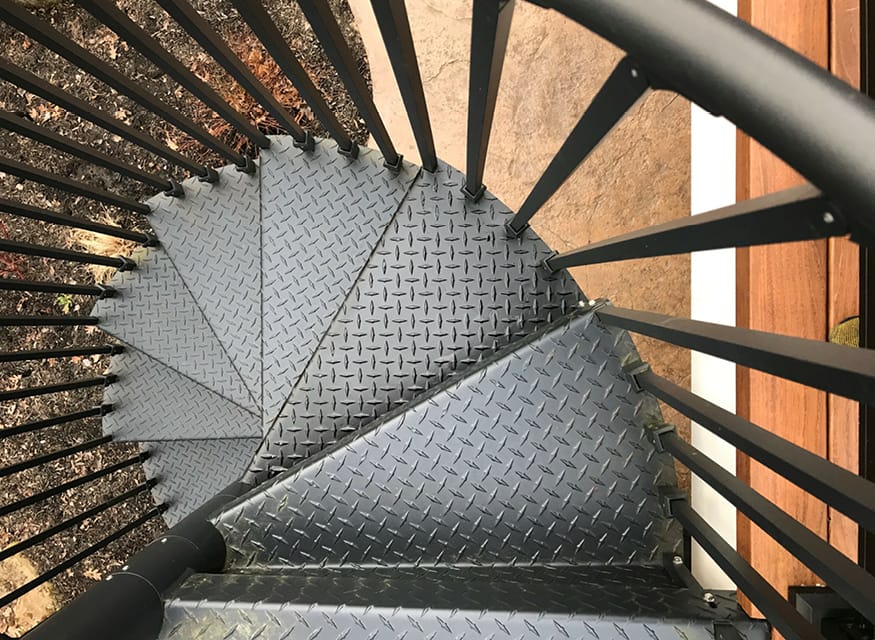Like every other part of a building, staircases require regular maintenance to ensure they remain safe, functional, and visually appealing. Neglecting staircase maintenance can lead to a range of issues, from unsightly dirt and grime buildup to potentially dangerous structural problems.
An ounce of prevention is worth a pound of cure, as the saying goes, and regular maintenance helps identify and address any issues before they become serious safety hazards.
Regular Cleaning
When dust and dirt are allowed to settle on your staircase for extended periods, they can become compacted and more difficult to remove. This is especially true for outdoor staircases, where debris from the surrounding environment can easily accumulate in the nooks and crannies of the stairs. Dusting your staircase should be fairly frequent if they see a lot of traffic or if you live in an especially dusty environment (such as the desert regions of the southwest).
In addition to dusting, your staircase may occasionally require a more thorough cleaning. Using a soft cloth or sponge, apply a diluted cleaning solution to your staircase, focusing on areas with stubborn dirt, smears, or fingerprints. Be sure to wring out the cloth or sponge well to avoid oversaturating the staircase materials. Gently scrub the affected areas, then wipe them down with a clean, damp cloth to remove any remaining soap residue.
When cleaning your staircase, it’s important to avoid using harsh chemicals or abrasive cleaning tools that could damage the protective layer of your staircase materials. Stick to gentle, pH-neutral cleaning solutions and soft cloths or sponges to prevent scratches, discoloration, or other damage to your stairs.
Proper Care and Routine Maintenance
In addition to regular cleaning, a few simple maintenance tasks ensure the long term safety and reliability of your staircase. This is especially true for outdoor stairs, which are exposed to the elements and may deteriorate more quickly without regular upkeep. A well-maintained staircase is less likely to have loose railings, uneven steps, or other hazards that could lead to accidents or injuries. Basic maintenance also significantly extends the lifespan of your staircase.
Inspecting for Damage
It’s important to perform periodic structural assessments of your spiral staircase to identify any signs of wear and tear. This may include checking for loose or wobbly railings, cracks or chips in the stairs or balusters, or rust or corrosion on metal components. If you do identify any worn or damaged components during your structural assessment, repair or replace them in a timely manner. This may involve tightening loose screws or bolts, filling in cracks or chips, or replacing severely damaged parts.
During your inspections, there are several key types of damage to look out for:
- Corrosion: This may include rust, discoloration, or flaking of the metal surface. Corrosion can weaken the structural integrity of metal parts over time, so it’s important to address it promptly.
- Wear: Look for signs of wear on the treads, risers, and handrails of your staircase. This may include scuffs, scratches, or worn-down areas. While some wear is normal over time, excessive wear can be a sign of underlying issues, such as loose or damaged components.
- Structural Shifts: Noticeable instability in your staircase is a red flag. Signs may include wobbling or creaking when you walk on the stairs, or visible gaps or misalignments between components. These issues can compromise the safety of your staircase if left unaddressed.
By catching and addressing potential issues early on, you can prevent accidents and injuries, and give yourself peace of mind knowing that your staircase is in good condition. If you’re unsure about the severity of an issue or how to address it, don’t hesitate to consult with a professional. A qualified contractor or staircase specialist can assess the damage and recommend the best course of action to keep your staircase safe and stable. And always contact the original manufacturer for genuine replacement parts.
Repairing or Replacing Worn or Damaged Parts
Even with regular cleaning and maintenance, there may come a time when certain parts of your staircase become worn or damaged. When this happens, promptly repair or replace these components to ensure the safety and longevity of your staircase.
This is particularly important for high-traffic staircases or those used by children, elderly individuals, or people with mobility issues. For example, a loose or broken handrail can make it difficult for people to maintain their balance while using the stairs, increasing the risk of falls or injuries. Similarly, worn or uneven tread surfaces can create tripping hazards, particularly for those with mobility issues or visual impairments.
The connection points between staircase components, such as the joints between treads and risers or the attachment points for balusters, can also become loose or damaged over time. Check for any signs of instability or wear, and tighten or replace the affected components as needed to maintain the structural integrity of your staircase.
Promptly repairing or replacing worn or damaged parts ensures that your staircase remains safe, stable, and functional for years to come. So make inspections and repairs a regular part of your maintenance routine, and don’t hesitate to seek professional help if needed to keep your staircase in top condition.
The Iron Shop combines four generations of old world craftsmanship with the latest manufacturing technologies to build beautiful, thoughtfully-designed, and easy to install staircases that will make any building more functional and attractive.

